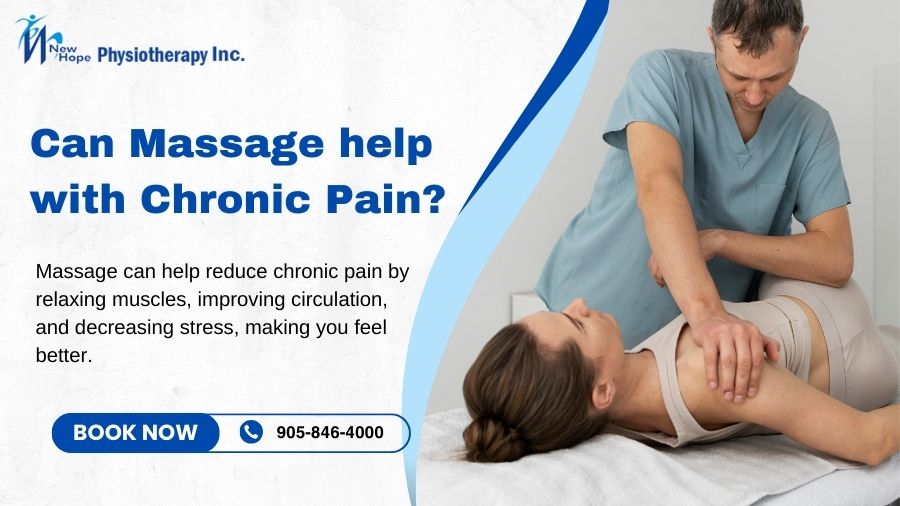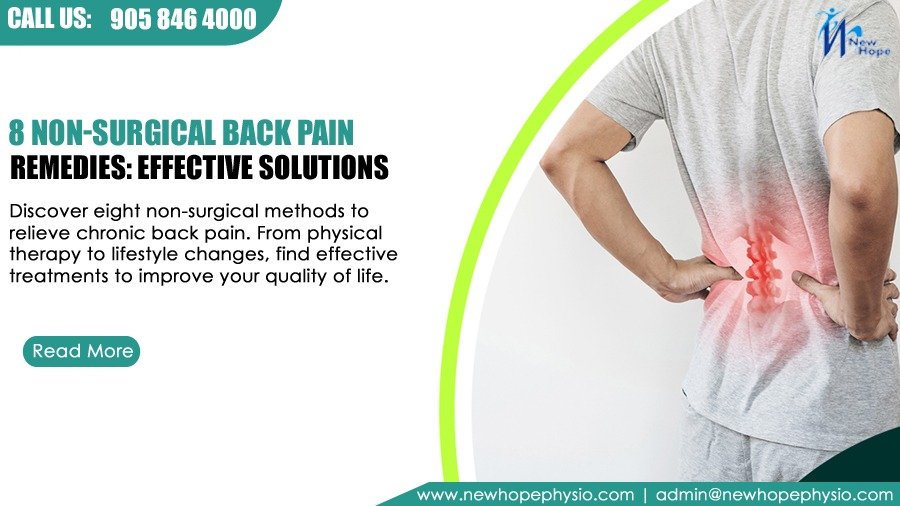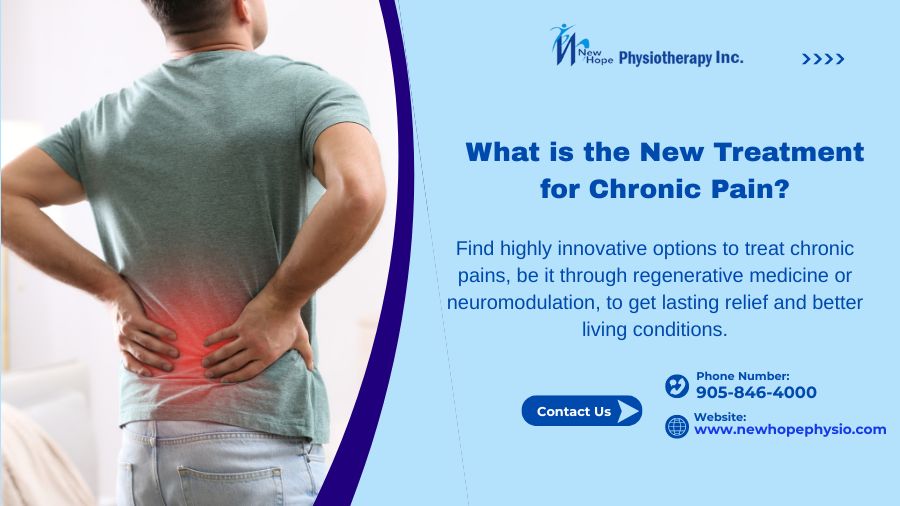
Welcome to New Hope Physiotherapy
- Brampton 905-846-4000
- Malton 905-364-3900
- Orangeville 519-217-9300
- admin@newhopephysio.com
- Home
- Blog
Non-Surgical Treatments for Chronic Back Pain: 8 Effective Methods
 5 Apr 2024
5 Apr 2024
- Comments
- 481
Non-Surgical Treatments for Chronic Back Pain: 8 Effective Methods
Chronic back pain may affect the quality of life to the extent of compromising daily activities and even health in general. Although the need in most cases requires surgical interventions, there are methods that can be used to provide relief to patients from the ordeal of chronic back pain without having to resort to surgery. You will find complete details about the eight non-surgical treatments for chronic back pain as well as efficient methods of back pain relief in this blog.
Also Read: 10 Gentle Workouts to Help Lower Back Pain at Home
8 Ways to Treat Back Pain without Surgery
1. Physical Therapy: The most important and easy way of treating chronic back pain is exercise. The exercises focus on stretching to improve flexibility. The books give clear advice on how to strengthen muscles, so people can stay flexible and maintain good posture. Designed by a qualified physical therapist, if at all, it will be specific, targeting certain painful or dysfunctional areas.
2. Exercise and Activity Modification: Exercise helps relieve chronic back pain. One may go for walks and swim, or even do some yoga, to ease up the blood flow and decrease the swelling while releasing endorphins, which is a natural painkiller present in the body. Further, modification of the daily activities to reduce or, if possible, avoid long sitting, lifting heavy weights, or movements several times may prevent the symptoms from becoming worse and do well to support the health of the spine. Mild exercises and ergonomic practices added to daily activities significantly contribute to the comfort of back pain and to the prevention of the return of symptoms.
3. Mind-Body Techniques: Complementary mind-body practices along with attention-distraction and relaxation techniques are found to be beneficial in controlling chronic back pain conditions. These could be, for instance, relaxation of the Progressive muscle relaxation, deep breathing and meditation practice. They contribute in both body and mind as well as lowering stress and anxiety further from the increased tension around the body that then leads into reduction of muscle tightness and consequently relaxation of muscles, and the pressure along the spine undergoes complete release. Participants of the mindfulness-based stress reduction programs have found them to achieve reduction in pain intensity at post-treatment follow-ups, improved functional status, and psychological well-being that thereby contributes holistically to methods of reducing and managing suffering among people with chronic back pain.
Also Read: What Are the 7 Principles of Massage Therapy?
4. Heat and Cold Therapy: The application of heat and cold therapy may give sudden relief from chronic back pain because it changes pain sensation and decreases inflammation.
Examples of heat therapy include hot packs and warm baths. Heat can relax tight muscles, increase blood flow, and ease discomfort.
Cold therapy uses ice packs or compresses. It helps numb the area, constrict blood vessels, and reduce swelling.
You can also alternate hot and cold treatments. This combined approach may relieve spine pain more effectively and improve mobility.
5. Massage Therapy: Massage therapy offers the patients suffering from chronic back pain physical and psychological relief.
Massage therapists use professional techniques such as Swedish massage, deep tissue massage, and trigger point therapy. These methods focus on easing tense muscles, relaxing knots, and improving blood circulation. This helps the body heal faster and reduces stress.
Massage also boosts the release of endorphins and serotonin. These natural chemicals control mood and reduce pain, making you feel relaxed and happy.
With regular sessions, massage can improve movement, lower physical discomfort, and increase flexibility. It is especially helpful for people who suffer from constant back pain.
6. Acupuncture: As for Chinese medicine, one of the most popular treatments among others can be the acupuncture process by means of piercing very thin needles into some body regions so as to reduce pain and increase vital energy.
Acupuncture needles work by targeting the nerve fibers that sense pain. This stimulation helps release endorphins and other neurotransmitters. These natural chemicals reduce pain and speed up the healing process.
Research shows that acupuncture is useful for people with chronic lower back pain. It provides lasting benefits, not only by reducing pain but also by improving movement and function.
Most people with ongoing back pain can benefit from acupuncture. It works best when used as part of a complete pain management program.
Also Read: The Path to Becoming an Acupuncturist in Canada: How Long Does It Take?
7. Chiropractic: This is a form of manipulation conducted by a professional in a careful manner, that allows the practitioner to adjust the spine with the aim of curing and these other musculoskeletal mechanical problems today, most of these being the spinal-related. Chiropractic care helps patients regain good musculoskeletal health. It works by realigning the spinal vertebrae, which reduces nerve compression and inflammation. As a result, arthritic pain decreases and overall movement improves.
Some studies suggest that chiropractic adjustments may help reduce chronic back pain. They can also improve spinal mobility and support a better quality of life. In many cases, combining chiropractic care with other non-surgical treatments brings even greater results. This approach can give people with long-term back pain almost complete relief.
Also Read: 5 Quick Home Remedies for Leg Cramp Relief and Prevention
8. Lifestyle Changes: Lifestyle changes are very important for the case of chronic back pain with recurrence. This may involve the maintenance of healthy body weight, eating well-balanced, anti-inflammatory nutritious food, good body hydration, and perfect sleeping habits. Smoking and drinking too much alcohol harm your spine and overall health. To keep your body strong, it’s important to avoid these habits. Meanwhile, it should make people be exposed to having ergonomic furniture or accessories, including a mattress and supportive chairs, or body mechanisms in carrying out their daily activities.
FAQs:
1. What are non-surgical treatments for chronic back pain?
Non-surgical treatments are safe methods used to reduce back pain without surgery. These may include physiotherapy, exercise, lifestyle changes, and pain management options.
Also Read: 10 Safe Ways to Treat Neck Pain during Pregnancy
2. Can exercise really help with chronic back pain?
Yes. Regular exercises, such as stretching, strengthening, and low-impact activities, improve posture, increase flexibility, and reduce long-term discomfort.
3. Is physiotherapy effective for back pain relief?
Physiotherapy is one of the most effective treatments. A physiotherapist designs a customized plan, including manual therapy, specific exercises, and posture correction to reduce pain and prevent future issues.
Also Read: Shoulder Pain Solutions: 7 Essential Exercises for Quick Relief
4. Are lifestyle changes important in managing back pain?
Yes. Healthy habits like maintaining a proper weight, sitting with good posture, regular walking, and avoiding heavy lifting can reduce pressure on the spine and ease back pain.
5. When should I seek medical advice for chronic back pain?
You should consult a healthcare professional if the pain is severe, lasts for more than a few weeks, or affects your sleep, work, or daily activities.
Conclusion
The chronic back pain should be addressed holistically, for we are dealing with a very complex illness. By using non-surgical approaches, people can greatly relieve their symptoms and improve their quality of life. They can do this through massage, physiotherapy, mind-body techniques, hot and cold therapies, massage, taking a small dose of pain killing medication, physical therapy, and making the right lifestyle changes. Without surgical intervention, they can get well, their discomfort can decrease, and the permanent relief they get will be long-lasting.
Also Read: Cupping Therapy: How Often Should You Schedule Sessions for Optimal Results?
Recent Posts
All Categories
- Acupuncture
- Arthritis
- Back Pain
- Chiropractic
- Chronic Pain
- Cupping Therapy
- Exercise
- Fibromyalgia
- Hamstring Pain
- Headaches
- Health
- Injury Clinic
- Joint Pain
- K Taping Therapy
- Knee pain
- Laser Therapy
- Manual Therapy
- Massage Therapist
- Massage Therapy
- Mental Health
- Motor Vehicle Accident
- Neck Pain
- Nerve pain
- Orthotics
- pelvic floor physiotherapy
- Physiotherapy
- Sciatica Pain
- Scoliosis Exercises
- Shockwave Therapy
- Shoulder pain
- Sports Physiotherapy
- VRT
- 905-846-4000
- 905.846.2100
- Kennedy Road & Sandalwood Road Unit#1, 170 Sandalwood Prky East Brampton, ON. L6Z 1Y5
MALTON
- 905-364-3900
- 905.676.9499
- Airport Road & Drew Road Unit# 139, 2960 Drew Rd. Mississauga, ON L4T 0A5
ORANGEVILLE
- 519-217-9300
- 519.217.9588
- Hwy 9 & Rolling Hills Drive Unit #4 , 50 Rolling Hills Drive Orangeville, ON L9W 4W2



Leave a Comment